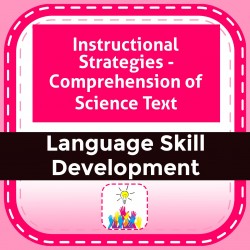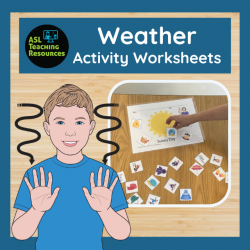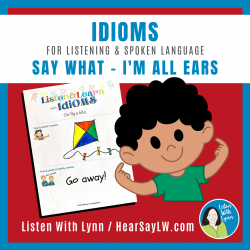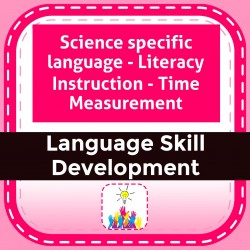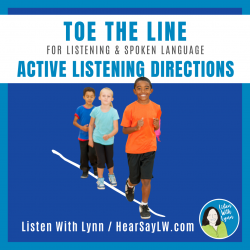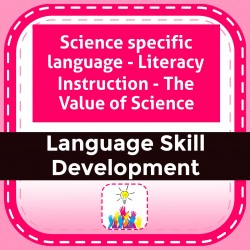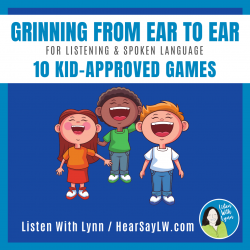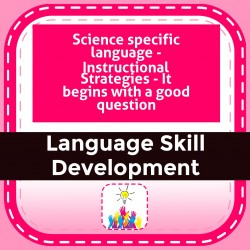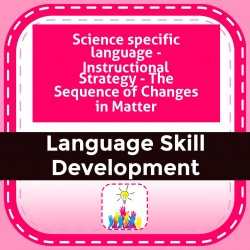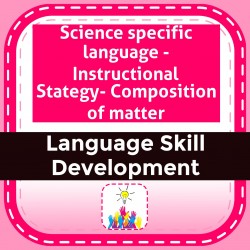Ability Levels
Categories
Resource Types
Age/Grade Range
CCSS
Anchor Standard
Speaking & Listening
Language
Reading
Instructional Strategies - Comprehension of Science Text
$ 3
It can be directions and procedures needed to conduct an experiment, an explanation of key facts in research reports needed to answer questions or solve a problem, or an expanded narrative in books, a
...
rticles, or websites providing background information. The child’s familiarity with the different formats and ability to comprehend information from them is closely related to general reading skills and competency. Includes strategies for activating prior knowledge, understanding text structures, and finding text evidence. See BUNDLE at S0XTEA0815.
ASL Weather Activity Worksheets
$ 299
Weather Activity Worksheets ASL combines developmental skills with language arts to help your students succeed. This fun activity will help you assess your student’s understanding of the weather, with
...
th the bonus of sign language. Weather is always a topic that students seem to be interested in, so using that interest to improve skills makes sense. This is an excellent activity for a Preschool, Pre-K, Kindergarten, or First Grade classroom Science Center.
Listen and Learn Idioms Set One I’m All Ears
$ 4
Listen and Learn Idioms SET ONE is part of a growing series of SAY WHAT? - I'M ALL EARS mini-lessons that are well-loved by kids and adults alike.Listen and Learn Idioms TARGET:Listening and spoken la
...
language, figurative language, vocabulary, word relationships, nuances, and higher-level critical thinking.IDEAL FOR: Listening & Spoken Language, Deaf & Hard of Hearing, Speech, ELA, Teletherapy, Distance Learning, Print…WHAT'S INCLUDED:PDFs of 20 idioms in every packet. Use one or all!Listen and Draw MINI-LESSON sheets with A box to draw and illustrate - THIS IS WHAT I HEARD A box for - SAY WHAT? THIS IS WHAT IT REALLY MEANS!A guide and instructions to makes lessons a piece of cakeData and Progress monitoring sheetsAn answer keyA boatload of book titles are included for further and home learningTerms of Use➯ The PDFs can be printed, screen shared in teletherapy or remote learning platforms, used in face-to-face sessions or lessons, and can be sent home for carryover or homework.SAY WHAT? Here's the trick to make idioms stick! Many commercially available resources provide ILLUSTRATIONS of the literal meaning of the idiom. While this may be entertaining RESEARCH indicates that children who:➼ LISTEN to the idiom➼ VISUALIZE the figurative language➼ DRAW what they literally heard followed by teaching the meaning andusing it in context increases long-term learning.Hearing LossChildren with typical hearing, learn idioms through incidental exposure without having to be taught. Whereas, children who are deaf and hard of hearing often require explicit and direct instruction with higher-level language like idioms. Idioms are challenging for children that process information literally and have a concrete or limited vocabulary.
Science specific language - Literacy Instruction - Time Measurement
$ 195
Scientific study is the observation and measurement of change. Use these instructional strategies to teach students the basic scientific units of time (standard and metric). Activities include exami
...
ning root parts such as "chrono," " -ology," reading comprehension and critical thinking, and ideas for extension lessons and student research.
Listening Directions Action Packed Toe The Line Game
$ 3
Listen, Learn, Move and Toe The Line!TOE THE LINE is an action-packed listening activity that targets basic concepts, verbs, and following one or multi-step directions and is full of giggles and wiggl
...
wiggles. It is well-loved by preschool and school-aged kids and can be easily leveled up or down to meet their goals.Ideal for: Parents, Audiologists, Speech Therapists, Auditory Verbal Therapist, Teachers of the Deaf and Hard of Hearing, Listening and Spoken Language, Early Intervention, Teletherapy, Distance LearningNo Prep! Grab a roll of colored or masking tape, make some space to target:✧ Action verbs✧ Basic concepts✧ Five different types of verbal directions➼ One, Two, and Multi-Step Directions➼ Sequential Directions involve following directions in a specific order.➼ Temporal Directions target the ability to follow directions containing the words “before”, “after” and “while” or “at the same time”.➼ Conditional Directions involve listening and deciding what actions to do based on the given condition(s).What's included:✤ The resource can be used as a parent handout or when coaching families✤ Suggested action verbs, concepts, and directions✤ Data monitoring and collection sheet✤ Listening and Spoken Language tips
Science specific language - Literacy Instruction - The Value of Science
$ 195
The
word ‘science’ comes from the Latin word for knowledge – scientia.
According to the Merriam -
Webster dictionary it is ‘knowledge about or study of the natural world based
on fac
...
on facts learned through
experiments and observation.” It is systematic, intellectual, and
practical.
Frequently, the instructional model for children who are deaf or hard of
hearing concentrates on language development and science learning is
considered to be extra. This
instructional material includes a lesson on SOUND as a means to exemplify a science instructional
strategy
10 Kid Approved Games Grinning From Ear To Ear
$ 6
TEN Kid-approved listening games and language activities for your grab-and-go toolbox. Each game includes specific goals to target such as following directions, auditory memory, processing, and compre
...
rehension while building language and communication. I have used these games with children for countless years. Expect lots of giggles and grins.Ideal for: Teletherapy, Speech, Listening and Spoken Language, Distance Learning, Classroom, No PrintWhat's included:A 21-page resource with:✧ 10 Ready to Go Games - No-Prep or very little preparation✧ Detailed Gameplay suggestions✧ Answers to each prompt when appropriate✧ A helpful guide and instructions✧ Listening and Spoken Language (LSL) Tips✧ Terms of Use10 GAMES AND GOAL AREAS1. Woot Woot! Booooo! targets listening, auditory processing and comprehension of connected speech at the sentence level.2. I’m Going On A ________ targets listening, auditory memory and recalling details in sequence.3. Bean Bag Boogie targets listening, multi-step directions, auditory processing and comprehension.4. Simon Says Or Not targets listening, auditory processing, following multi-step directions and instructions.5. Thumbs Up. Thumbs Down targets listening, auditory processing and comprehension of connected speech at the sentence level.6. I Say - Go targets listening, temporal auditory memory skills, auditory processing and following multi-step directions.7. Found Sounds Outdoor Scavenger Hunt targets listening, identifying and localizing common outdoor sounds and their descriptors.8. Ear To Ear - Back To Back targets listening, auditory processing, following and giving directions, joint attention, two-way communication skills and cooperation.9. Do What You Hear Not What You See targets listening, following complex directions and auditory processing with distractions.10. Draw A Rhyme targets listening, following directions, auditory closure, phonemic awareness, recognizing and generating rhyming words.
Science specific language - Instructional Strategies - It begins with a good question
$ 195
When you say ‘science’, one thinks of experiments and research. To do research, scientists conduct experiments to answer questions and learn new information. These experiments follow a specific sequen
...
quence of steps called, ‘The Scientific Method’. Use these instructional strategies and activities to help students understand the Scientific Method and how it is applied to science experiments. Activities include determining the difference between a statement and a question, practice writing questions, understanding measurable/ non-measurable information, naming components of an experiment, and conducting an experiment using the Scientific Method.
Science specific language - Instructional Strategy - The Sequence of Changes in Matter
$ 195
Changes in the state of matter are physical changes, not chemical changes. When a substance moves from one phase to another it is still the same substance. These instructional strategies and activitie
...
s can be used to introduce or reinforce states of matter. Activities include sentence completion, categorization, finding text evidence, and using critical thinking.
Science specific language - Instructional Stategy- Composition of matter
$ 195
In examining students’ writing samples, there is often a lack of description related to the aspects of composition. For example, most students are familiar with and describe color, shape, size, and lo
...
location but what something is made of is frequently left out. Using the periodic table and understanding chemical elements can support the awareness of composition. Use of this knowledge can expand descriptive writing. These instructional strategies and activities can be used across the curriculum to reinforce understanding of elements and how they relate to everyday life. Activities include matching elements to every day objects, creating a class periodic table, student research, and how elements are used to produce fireworks.
 Your browser is out of date. For best experience switch to latest updated Browser.
Your browser is out of date. For best experience switch to latest updated Browser.
 Get Chrome
Get Chrome Get Edge
Get Edge Get Firefox
Get Firefox